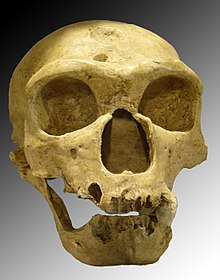Neandertals
| Neanderthal Temporal range: – 0.250–0.040 Ma |
|
|---|---|
 |
|
| The Neanderthal skull of La Chapelle-aux-Saints 1 | |
 |
|
| An approximate reconstruction of a Neanderthal skeleton at the American Museum of Natural History | |
| Scientific classification | |
| Kingdom: | Animalia |
| Phylum: | Chordata |
| Class: | Mammalia |
| Order: | Primates |
| Suborder: | Haplorhini |
| Family: | Hominidae |
| Genus: | Homo |
| Species: | H. neanderthalensis or Homo sapiens neanderthalensis |
| Binomial name | |
|
Homo neanderthalensis or Homo sapiens neanderthalensis King, 1864 |
|
 |
|
| Range of Homo neanderthalensis. Eastern and northern ranges may extend to include Okladnikov in Altai and Mamotnaia in Ural | |
| Synonyms | |
|
Homo mousteriensis |
|
Homo mousteriensis
Palaeoanthropus neanderthalensis
Neanderthals, or more rarely Neandertals, (UK /niˈændərˌtɑːl/, us also /neɪ/-, -/ˈɑːndər/-, -/ˌtɔːl/, -/ˌθɔːl/; named for the Neandertal region in Germany) were a species or subspecies of archaic humans in the genus Homo that went extinct about 40,000 years ago. Neanderthals and modern humans share 99.7% of their DNA and are hence closely related. (By comparison, both modern humans and Neanderthals share 98.8% of their DNA with their closest non-human living relatives, the chimpanzees.) Neanderthals left bones and stone tools in Eurasia, from Western Europe to Central and Northern Asia. Fossil evidence suggests Neanderthals evolved in Europe, separate from modern humans in Africa for more than 400,000 years. They are classified either as a distinct species, Homo neanderthalensis, or as a subspecies of Homo sapiens (H. s. neanderthalensis).
...
Wikipedia
